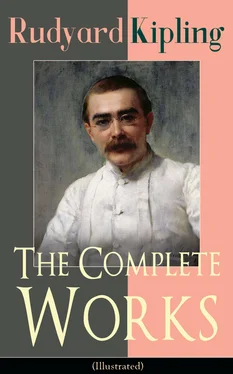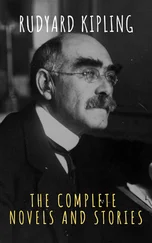There was an old puzzle-map of the World in the House. Lispeth had played with it when she was a child. She unearthed it again, and put it together of evenings, and cried to herself, and tried to imagine where her Englishman was. As she had no ideas of distance or steamboats, her notions were somewhat erroneous. It would not have made the least difference had she been perfectly correct; for the Englishman had no intention of coming back to marry a Hill girl. He forgot all about her by the time he was butterfly-hunting in Assam. He wrote a book on the East afterwards. Lispeth's name did not appear.
At the end of three months, Lispeth made daily pilgrimage to Narkunda to see if her Englishman was coming along the road. It gave her comfort, and the Chaplain's wife, finding her happier, thought that she was getting over her "barbarous and most indelicate folly." A little later the walks ceased to help Lispeth and her temper grew very bad. The Chaplain's wife thought this a profitable time to let her know the real state of affairs—that the Englishman had only promised his love to keep her quiet—that he had never meant anything, and that it was "wrong and improper" of Lispeth to think of marriage with an Englishman, who was of a superior clay, besides being promised in marriage to a girl of his own people. Lispeth said that all this was clearly impossible, because he had said he loved her, and the Chaplain's wife had, with her own lips, asserted that the Englishman was coming back.
"How can what he and you said be untrue?" asked Lispeth.
"We said it as an excuse to keep you quiet, child," said the Chaplain's wife.
"Then you have lied to me," said Lispeth, "you and he?"
The Chaplain's wife bowed her head, and said nothing. Lispeth was silent, too for a little time; then she went out down the valley, and returned in the dress of a Hill girl—infamously dirty, but without the nose and ear rings. She had her hair braided into the long pig-tail, helped out with black thread, that Hill women wear.
"I am going back to my own people," said she. "You have killed Lispeth. There is only left old Jadeh's daughter—the daughter of a pahari and the servant of Tarka Devi. You are all liars, you English."
By the time that the Chaplain's wife had recovered from the shock of the announcement that Lispeth had 'verted to her mother's gods, the girl had gone; and she never came back.
She took to her own unclean people savagely, as if to make up the arrears of the life she had stepped out of; and, in a little time, she married a wood-cutter who beat her, after the manner of paharis, and her beauty faded soon.
"There is no law whereby you can account for the vagaries of the heathen," said the Chaplain's wife, "and I believe that Lispeth was always at heart an infidel." Seeing she had been taken into the Church of England at the mature age of five weeks, this statement does not do credit to the Chaplain's wife.
Lispeth was a very old woman when she died. She always had a perfect command of English, and when she was sufficiently drunk, could sometimes be induced to tell the story of her first love-affair.
It was hard then to realize that the bleared, wrinkled creature, so like a wisp of charred rag, could ever have been "Lispeth of the Kotgarh Mission."
Table of Contents
"When halter and heel ropes are slipped, do not give chase with
sticks but with gram."
—Punjabi Proverb.
After marriage arrives a reaction, sometimes a big, sometimes a little one; but it comes sooner or later, and must be tided over by both parties if they desire the rest of their lives to go with the current.
In the case of the Cusack-Bremmils this reaction did not set in till the third year after the wedding. Bremmil was hard to hold at the best of times; but he was a beautiful husband until the baby died and Mrs. Bremmil wore black, and grew thin, and mourned as if the bottom of the universe had fallen out. Perhaps Bremmil ought to have comforted her. He tried to do so, I think; but the more he comforted the more Mrs. Bremmil grieved, and, consequently, the more uncomfortable Bremmil grew. The fact was that they both needed a tonic. And they got it. Mrs. Bremmil can afford to laugh now, but it was no laughing matter to her at the time.
You see, Mrs. Hauksbee appeared on the horizon; and where she existed was fair chance of trouble. At Simla her bye-name was the "Stormy Petrel." She had won that title five times to my own certain knowledge. She was a little, brown, thin, almost skinny, woman, with big, rolling, violet-blue eyes, and the sweetest manners in the world. You had only to mention her name at afternoon teas for every woman in the room to rise up, and call her—well—NOT blessed. She was clever, witty, brilliant, and sparkling beyond most of her kind; but possessed of many devils of malice and mischievousness. She could be nice, though, even to her own sex. But that is another story.
Bremmil went off at score after the baby's death and the general discomfort that followed, and Mrs. Hauksbee annexed him. She took no pleasure in hiding her captives. She annexed him publicly, and saw that the public saw it. He rode with her, and walked with her, and talked with her, and picnicked with her, and tiffined at Peliti's with her, till people put up their eyebrows and said: "Shocking!" Mrs. Bremmil stayed at home turning over the dead baby's frocks and crying into the empty cradle. She did not care to do anything else. But some eight dear, affectionate lady-friends explained the situation at length to her in case she should miss the cream of it. Mrs. Bremmil listened quietly, and thanked them for their good offices. She was not as clever as Mrs. Hauksbee, but she was no fool. She kept her own counsel, and did not speak to Bremmil of what she had heard. This is worth remembering. Speaking to, or crying over, a husband never did any good yet.
When Bremmil was at home, which was not often, he was more affectionate than usual; and that showed his hand. The affection was forced partly to soothe his own conscience and partly to soothe Mrs. Bremmil. It failed in both regards.
Then "the A.-D.-C. in Waiting was commanded by Their Excellencies, Lord and Lady Lytton, to invite Mr. and Mrs. Cusack-Bremmil to Peterhoff on July 26th at 9.30 P. M."—"Dancing" in the bottom-left-hand corner.
"I can't go," said Mrs. Bremmil, "it is too soon after poor little Florrie—but it need not stop you, Tom."
She meant what she said then, and Bremmil said that he would go just to put in an appearance. Here he spoke the thing which was not; and Mrs. Bremmil knew it. She guessed—a woman's guess is much more accurate than a man's certainty—that he had meant to go from the first, and with Mrs. Hauksbee. She sat down to think, and the outcome of her thoughts was that the memory of a dead child was worth considerably less than the affections of a living husband.
She made her plan and staked her all upon it. In that hour she discovered that she knew Tom Bremmil thoroughly, and this knowledge she acted on.
"Tom," said she, "I shall be dining out at the Longmores' on the evening of the 26th. You'd better dine at the club."
This saved Bremmil from making an excuse to get away and dine with Mrs. Hauksbee, so he was grateful, and felt small and mean at the same time—which was wholesome. Bremmil left the house at five for a ride. About half-past five in the evening a large leather-covered basket came in from Phelps' for Mrs. Bremmil. She was a woman who knew how to dress; and she had not spent a week on designing that dress and having it gored, and hemmed, and herring-boned, and tucked and rucked (or whatever the terms are) for nothing. It was a gorgeous dress—slight mourning. I can't describe it, but it was what The Queen calls "a creation"—a thing that hit you straight between the eyes and made you gasp. She had not much heart for what she was going to do; but as she glanced at the long mirror she had the satisfaction of knowing that she had never looked so well in her life. She was a large blonde and, when she chose, carried herself superbly.
Читать дальше












